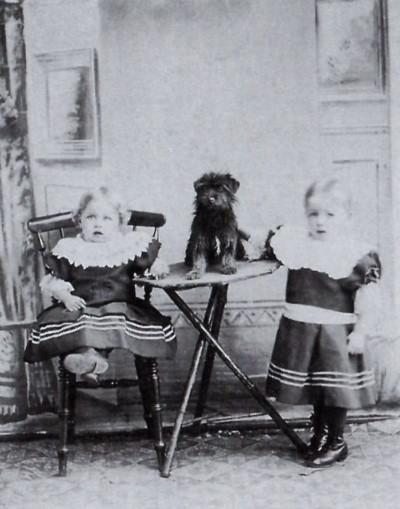Girls were dressed similar to their mothers but, of course, they did not have such elaborate hats or such long skirts or dresses. Their hats were mostly straw ones trimmed with flowers or ribbon and with some elastic fastened to the brim at each side and hooked under the chin. Often this elastic got well chewed. Liberty bodices were worn in place of corsets until the child became a teenager.
For playing outside, shawls were worn on the shoulders after folding into a triangle. The ends were crossed over the chest and tied at the back. They were cosy and warm for the chest. The shawls, which were either home knitted or crocheted were very useful. If a woman had to go up the street, she never went without a head covering and so she would often take a shawl, place it over her head and tie it under her chin. Old people often wore them in the house.

Jack & Harry Hoban
In winter, children often wore a little bag fastened round their neck with tape hanging close to their skin. The bag would contain a block of camphor to ward off colds. The tiny ones would have a hanky or a scrap of material which was fastened to their pinny so that they would not lose it. They all wore pinnies for school often nice, white starched ones. All babies, at first, wore very long garments.
All boys were kept dressed as girls until they were five years old and ready to start school. They were then britched. Their long hair was cut short and a penny was given to them. No one really knows why boys were kept in petticoats. Was it because mothers were too busy to see to toilet arrangements or were they afraid that some bad men might steal little boys. For school, boys wore white collars, sort of Peter Pan shaped. These collars would be bought and were made of a celluloid like material so they had to be wiped over with a damp soapy cloth. If they arrived at school with a dirty collar, dirty hands or boots the result was often a cane slapped over their hands. Boys always wore short trousers until well into their teens.
For a very special occasion which called for a starched white shirt, a 'dickie' could be used. This was a stout sheet resembling a shirt front which could be used to cover up the front of a flannel shirt and which was attached to the accompany-ing collar. The word 'dickie' also meant the extra, outside seat at the back of a small car.